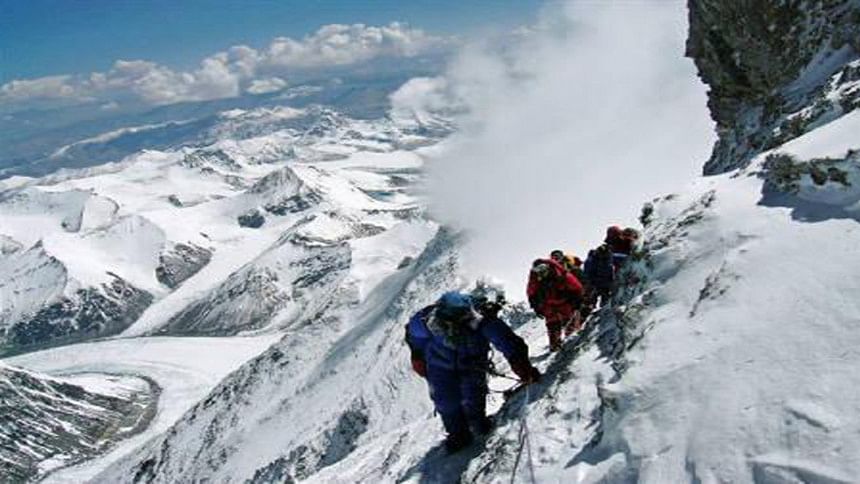Nepal tourism envisions rebound plan after quake

The devastating earthquake of April 25 has left Nepal’s fragile infrastructure in ruins, its popular trekking trails scarred by landslides and iconic World Heritage Sites in tatters.
In just one short week, almost all the foreign sightseers have left the country. It’s unclear when the tourists will return.
However, travel trade entrepreneurs are very optimistic about the future of Nepal’s tourism industry.
The importance of the tourism sector in Nepal can be gauged from the fact that it has a multiplier effect on the economy in the form of job creation and rural earnings.
According to Tourism Employment Survey 2014 conducted by the tourism ministry, every six tourists create one job in Nepal, and the tourism industry provides poor communities better access to revenues generated by the tourism market.
The private sector and the government has joined hands to bring about a speedy recovery from the devastating earthquake’s repercussions by setting up a recovery taskforce to recommend appropriate measures for the industry’s turnaround.
“In the short-term, tourism is likely to drop almost to zero, but things are going to get better in the days ahead,” said Ashok Pokhrel, president of the Nepal Association of Tour Operators.
“Before going for global marketing and preparing new itineraries, the recovery taskforce will sketch out a plan and hire international experts who will recommend actions to produce a solid rebound in the country’s tourism industry.”
As per the plan, the taskforce will study the damage caused to the trekking routes, World Heritage Sites and varied infrastructure and list the resources required for their reconstruction. However, a number of experts say that the damage to the tourism infrastructure and cultural zones would have a negative impact on the country’s tourism economy and traveller confidence in the long term.
Nepal’s travel and tourism sector directly generated 487,500 jobs last year representing 3.5 per cent of the total employment in the country, according to a World Travel and Tourism Council (WTTC) report.
In terms of absolute contribution to job creation by the travel and tourism sector, Nepal is ranked 38th among 184 countries.
The direct contribution of Nepal’s travel and tourism to the GDP in 2014 was 83.7 billion rupees (US$81.79 million) or 4.3 per cent of the GDP. This is forecast to rise 5.4 per cent to 88.2 billion rupees in 2015.
Nepal has observed sustained growth in international tourist arrivals since June 2009. The country received 509,956 tourists in 2009 and in 2013 the figure jumped to 800,000.
Trekking and mountaineering are the main draws for tourists.
“Therefore, we need to assure travellers that their favourite trekking and hiking trails are intact,” said Ramesh Dhamala, president of the Trekking Agencies Association of Nepal (Taan). An estimated 30 per cent of the total tourists go trekking in the Himalayan foothills.
According to Dhamala, some of the popular trekking trails like Manaslu, Ganesh Himal, Ruby Valley, Langtang and Rolwaling have been destroyed completely.
“Some routes can be repaired while most need to be restored from scratch,” he said, adding that Taan was conducting a detailed study of the damaged trails. Dhamala estimates that at least 150-200 million rupees will be needed to reconstruct the walking paths.
A tourism ministry survey shows that the trekking sector is the largest employer in the tourism industry followed by tourist standard hotels, travel agencies, star hotels and international airlines. According to the survey, the 1,636 trekking agencies in the country provided 50,004 jobs in 2014.
Meanwhile, an increased number of deaths on the scenic mountains, particularly Everest, has emerged as another worry.
Last year on April 18, an avalanche on Everest killed 16 guides. This year too, at least 19 climbers including high-altitude guides died in an avalanche triggered by the April 25 earthquake.
Peak climbing in Nepal is considered to be high-end tourism as it brings income to porters, kitchen staff, high-altitude guides and expedition and gear agencies.
A guide on Everest normally earns $6,000 to $7,000 during the three-month climbing season.
Government revenues amount to about $3.9 million annually in climbing fees, $3.5 million from Everest alone.
Luxury and budget hotels, restaurants and bars in Pokhara, Thamel and other tourist areas have borne the brunt of the slump n tourism.
There has been a noticeable absence of backpackers and budget travellers on the streets of Thamel and Pokhara since the tremor despite this being the height of the tourist season.
While European and American visitors prefer adventure activities, tourists from Southeast Asia come to Nepal mainly to visit religious sites.
“And they will certainly feel let down if the cultural and architectural structures are not restored speedily,” said Pokhrel.
The earthquake reduced a majority of the valley’s Unesco World Heritage Sites to rubble. Damage has been caused to numerous historic buildings and archaeological locations, including six Unesco World Heritage Sites, namely Kathmandu Durbar Square, Patan Durbar Square and Bhaktapur Durbar Square and the shrines of Swayambhu, Changu Narayan and Bouddha.
- The Kathmandu Post/Asia News Network

 For all latest news, follow The Daily Star's Google News channel.
For all latest news, follow The Daily Star's Google News channel. 



Comments